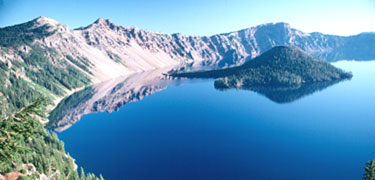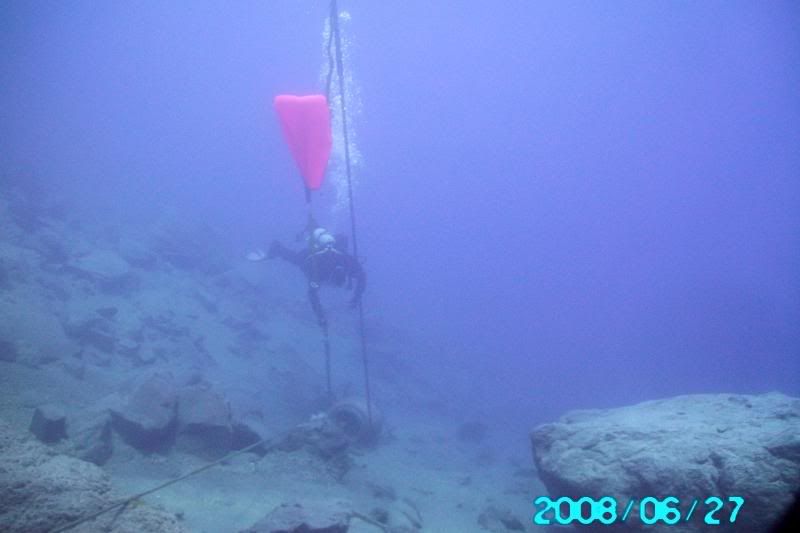[SIZE=+4]Crater Lake[/SIZE] [SIZE=-1]National Park Service
U.S. Department of the Interior
Crater Lake National Park[/SIZE] [SIZE=+2]SCUBA Diving[/SIZE] SCUBA divers in Crater Lake National Park face special challenges. For the dedicated diver, however, the lake also offers a unique experience. Crater Lake is the deepest lake in the United States, and one of the clearest fresh water lakes in the world.
Keep in mind that Crater Lake is accessible for divers only from about June 15 through September 15 of each year due to our extreme snow conditions. Earlier or later dives may be possible, but cannot be guaranteed due to the variability of our weather.
Permits and Dive Tables All divers are required to obtain a diving permit in person upon arrival at the park. The permit is free of charge, and is available between the hours of 8:00 am and 4:30 pm daily. Permits are only issued from the Canfield Building (Ranger Station) in the Park Headquarters complex. A ranger will confirm your diving ability and give you specific information about diving in the lake. The lake level is at 6,173 feet in elevation, so high altitude dive tables should be used in planning your dive. Most divers use the 8,000 foot table.
Access to the Lake Crater Lake is accessible for diving only by hiking the Cleetwood Trail, located on the north side of Crater Lake. The Cleetwood Trail is 1.1 miles in length and descends 700 feet to the lake surface. You must be able to carry all your equipment up and down the trail. Wheeled vehicles are prohibited. Restrooms are available at the top and bottom of the Cleetwood Trail but there are no food or drinking water facilities.
You may dive from the Cleetwood Cove dock near the lake level gauge. You may also dive from Wizard Island; however, the island is only accessible by taking one of the concession-operated boat tours. A ranger-naturalist narrates the tour, so plan on arriving to Wizard Island about forty minutes after departing from the Cleetwood Cove dock. Contact the park at (541) 594-3100, for tour prices and a current schedule. Prior arrangements must be made with the concessioner, as space on the tour boats is limited. After your dive, you may return to Cleetwood Cove by catching a later boat tour, on a space-available basis. No one is allowed to stay on Wizard Island overnight. There are no drinking water or other facilities on Wizard Island. If lightning threatens, boat tours may be cancelled.
Reminders and Regulations You must carry out everything that you carried in. Minimum impact visiting is a requirement.
Private boats and rafts are not allowed on the lake. Only interpretive boat tours and research vessels are permitted. Crater Lake is preserved as a scenic and scientific wonder, not as a recreational lake.
Because the water is quite cold (temperatures below the surface are consistently in the upper 30’s), a good quality, 0.25-inch full wet suit or a dry suit is required.
Diving is prohibited within 100 feet of the Cleetwood Cove dock and mooring facilities, and within 100 feet of the Wizard Island dock.
No solo diving is permitted under any circumstances. A “diver down” flag is required.
No collecting of rocks, plants, or other features is permitted. No spearfishing is permitted.
The nearest full decompression chamber is more than 300 miles from the park.
All divers must be certified NAUI, PADI, or similar-type divers and must bring proof of certification with them.
Air refills are not available in the park. The closest facilities for this are dive shops in Klamath Falls, Medford, Phoenix, and Grants Pass.
Exploring Deep Blue An average annual precipitation of 67 inches, primarily in the form of snowmelt, keeps Crater Lake at a fairly constant depth. At its deepest point, Crater Lake is 1,943 feet deep, making it the deepest lake in the United States and the seventh deepest in the world.
Surface temperatures in Crater Lake vary from 32° to 65°F. The average summer temperature is 50° to 58°F. Below 260 feet, the temperature is a constant 38°F.
Once under the surface, you will find Crater Lake varied in appearance. As in any natural body of water, you may encounter sediments, algae, and suspended materials. Phytoplankton and zooplankton live in the lake, along with two species of fish (kokanee salmon and rainbow trout), which were introduced in the late 1800s. Moss grows along the caldera walls to depths of more than 400 feet.














